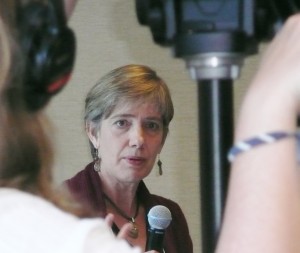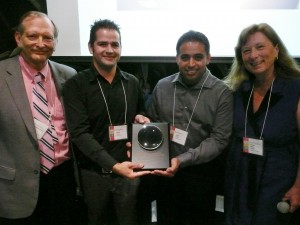Our annual meeting in Sacramento was a great success and source of inspiration. From the stimulating discussion of our Rural Summit to the Legislative Advocacy Day, there was never a dull moment. About 65 people participated throughout the event. Thanks to the CAMEO members, award winners, friends and legislators who gathered to support micro-business in California.
Check our our photos on Facebook MicroBizCA – and like us while you’re there.
Rural Summit
Self-employment is THE Labor Market Trend
Faces of Entrepreneurship Awards
Legislative Advocacy Day
RURAL SUMMIT
The Rural Summit started with a guest star, albeit by video. Zappos founder Tony Hsieh presented his Themes from City As Start Up talk about his company’s plans to transform downtown Las Vegas into the “most community-focused large city in the world.” Start the video around 19:00 minutes where he starts discussing the following themes:
- Co-Learning and Co-Working
- Return on Community & Luck
- Innovation: Ideas from outside your industry
- Idea Generation: Strategic Interactions
- Accelerate Collisions
- Organic Process
- Edifice Complex
- Curated Content
- Create Density
- Make it Convenient
- Not all jobs are created equal, so focus on the creative class of entrepreneur
Then Susan Brown and our two guest speakers guided us through a facilitated discussion about what they are doing to help build community and local business in rural areas and how Hsieh’s concepts of ‘city as a start-up’ can be applied to rural development.
Nathan Johnston is a Builder/Maker/Doer and CEO of Pusher in Dusmuir, CA’ Gina Lujan is the Director of Hacker Lab in Sacramento and is working with Tuolome County to determine what the human capital resources are in that area. (Speaker Bios)
One of the big topics of conversation was where economic development resources should go. Suggestions included:
*Foster high level partnerships between fields and industry for cross pollination of ideas.
*Support Benefit Corporations.
*Ensure legal and tax structures are supportive and not obstructionist.
*Foster a start-uppy attitude; inspire curiousity and creativity.
*Research existing talent and resources – find out what’s happening in your backyard, even those hobbyists, an invisible business might emerge as the next big thing.
*Foster the ‘maker-culture’.
*Re-imagine leadership: include private industry; once you find your local leaders hand it over to them.
*Change the metrics of success, e.g. create sustainable employment for 40 year-old single mothers.
*To quote another famous shoe icon: Just Do It. Stop waiting for something to happen and rescue your town.
A big thanks to Glenda Humiston (bio), the California State Director at the U.S. Department of Agriculture (USDA), Rural Development. Dr. Humiston stopped by to talk about the work she’s doing to uncover new models of economic development in rural areas or applying old ideas in new ways, such as vertical co-op arrangements. The example she gave is that the piece missing in the supply chain for organic meet is the slaughterhouse. Problem is that being in the slaughterhouse business is not particularly profitable in California, so the business is shipped elsewhere. Dr. Humiston is working with other pieces of the supply chain to ‘subsidize’ the slaughterhouse, so that the other pieces of the organic meat supply chain can thrive in California.
SELF-EMPLOYMENT IS THE LABOR MARKET TREND
 Carolyn Ockels (see pic left) and Steve King (bios) presented their research on self-employment, State of Independence Report. They have found a “conscious structural shift and recognition of a new model of work and engagement” and that is toward self-employment. The number of independent workers grew from 16 million in 2011 to 16.9 million in 2012 and it’s expected to grow by 35% over the next five years. Self-employment is a labor market trend. A special thanks goes to Barbara Vohryzek, the deputy director of small business at the Governor’s Office of Business and Economic Development, who participated in the session. We hope she brings these trends back to the governor!
Carolyn Ockels (see pic left) and Steve King (bios) presented their research on self-employment, State of Independence Report. They have found a “conscious structural shift and recognition of a new model of work and engagement” and that is toward self-employment. The number of independent workers grew from 16 million in 2011 to 16.9 million in 2012 and it’s expected to grow by 35% over the next five years. Self-employment is a labor market trend. A special thanks goes to Barbara Vohryzek, the deputy director of small business at the Governor’s Office of Business and Economic Development, who participated in the session. We hope she brings these trends back to the governor!
Members discussed what these trends mean for our programs and how to improve the data collection and studies done on the sector. Read more by our data guru, Andrew Cole – “The Future of Micro-Biz Data.” Download their Independent Worker Presentation.
FACES OF ENTREPRENEURSHIP AWARDS
 We were excited and proud to honor two assemblymembers who have championed systems change in the workforce by introducing two bills that increase self-employment within that system. We thank them for their leadership.
We were excited and proud to honor two assemblymembers who have championed systems change in the workforce by introducing two bills that increase self-employment within that system. We thank them for their leadership.
- Assemblywoman Mariko Yamada, (D-Davis) authored AB 152, Self-Employment Assistance program, a bill that would allow the unemployed to keep their benefits while starting their own businesses. Unfortunately, the bill is stuck in appropriations because the state says that the cost of the program exceeds the $5.3 million available from the federal government to run the program.
- Assemblywoman Cheryl Brown, (D – San Bernardino) is the author of AB 285, Micro Enterprise: Economic Development, a bill that encourages the California state Workforce Investment Board to set guidelines for local WIBs to incorporate entrepreneurship training.
And drumroll for the winners of the third annual CAMEO Face of Entrepreneurship Awards – Don Polvoron from Hayward and iResult from Monterey, two small businesses that created jobs in a less than ideal economic climate and represent the spectrum of entrepreneurship. (See pic right of Jorge and Oscar Flores of Don Polvoron.)
“CAMEO initiated the Faces award to celebrate the true job creators, – the small businesses that build sustainable communities,” said Claudia Viek, C.E.O. of CAMEO. “These micro-businesses will be the growth engine of the 21st century economy.”
LEGISLATIVE ADVOCACY DAY
We had a busy Thursday morning before we went off to see our legislators.
We started the day with a visit from Eric Mandell, the Acting Chief of the Acquisitions Branch for the Department of General Services… i.e. the guy who’s in charged with buying stuff for the state of California. And yes the state buys from micro-businesses – 25% of $8 billion in procurement are from a certified California Small Business. Recently the number of small business selling to the state has gone from 10,300 to 22,000. The certification process used to be a 28-page application, now its an online application that takes about an hour to fill out. Learn more about how to do business with California. Even though he didn’t give a powerpoint, you can download Eric’s slide deck about How to do Business with California.
Ann Sullivan (bio), the President of Madison Services Group, Inc. gave us a low down on CAMEO’s 2013 federal legislative priorities: SBA, USDA and Treasury funding, Workforce and the Self-employment Assistance Program. The news on the federal front is as it is everywhere – budget cuts. We will fight for our programs, but it’s difficult when the SBA doesn’t have a champion for micro.
Casey Elliot and Ashley Setoudeh from Townsend Public Affairs explained the current political climate in Sacramento, which is much better than it’s been in years. For the first time in a while, the word ‘showdown’ is no where to be found. Legislators and the governor have came to terms with the state’s fiscal situation and in all likelihood will pass a budget before the June 30, 2013 deadline. Casey told members that legislators were thinking about economic development.
So do we have a good one for them… self-employment is an economic development tool – that creates at least one job for the owner and in three years an additional two jobs. We took that message as well as support for AB 285, AB 172 and AB1 173 (procurement bills) to the legislature. Download the talking points we used for the meetings and tips from Ashley on how to make an Effective Position Presentation.
